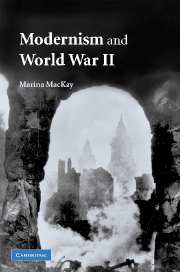Book contents
- Frontmatter
- Contents
- Acknowledgements
- Introduction: Modernism beyond the Blitz
- Chapter 1 Virginia Woolf and the pastoral patria
- Chapter 2 Rebecca West's anti-Bloomsbury group
- Chapter 3 The situational politics of Four Quartets
- Chapter 4 The neutrality of Henry Green
- Chapter 5 Evelyn Waugh and the ends of minority culture
- Coda: National historiography after the post-war settlement
- Notes
- Bibliography
- Index
Introduction: Modernism beyond the Blitz
Published online by Cambridge University Press: 22 September 2009
- Frontmatter
- Contents
- Acknowledgements
- Introduction: Modernism beyond the Blitz
- Chapter 1 Virginia Woolf and the pastoral patria
- Chapter 2 Rebecca West's anti-Bloomsbury group
- Chapter 3 The situational politics of Four Quartets
- Chapter 4 The neutrality of Henry Green
- Chapter 5 Evelyn Waugh and the ends of minority culture
- Coda: National historiography after the post-war settlement
- Notes
- Bibliography
- Index
Summary
What we call the beginning is often the end
And to make an end is to make a beginning
The end is where we start from.
T. S. Eliot, Little Gidding (1942)‘Either you had no purpose’, Eliot writes in his wartime Little Gidding, ‘Or the purpose is beyond the end you figured / And is altered in fulfilment’. The work of a poet concluding a career of unparalleled significance, Eliot's Four Quartets speculate continually about what it would mean to make a good end, where an end is an objective or a conclusion, an intended destination or just a termination – and perhaps, but not necessarily, both. So if I begin this book by saying that its subject is the end of modernism, I mean ‘end’ in Eliot's double sense: the end of modernism signifies both its realisation and its dissolution. Vindicated, certainly, but melancholy in its vindication, the mood of late modernism in England resembles the watershed event that it recorded: the Second World War, too, was both a win and a winding up. In the chapters that follow, I suggest that the correlation between late modernism in England and the world-changing circumstances with which it overlapped amounts to more than a historical coincidence.
- Type
- Chapter
- Information
- Modernism and World War II , pp. 1 - 21Publisher: Cambridge University PressPrint publication year: 2007



